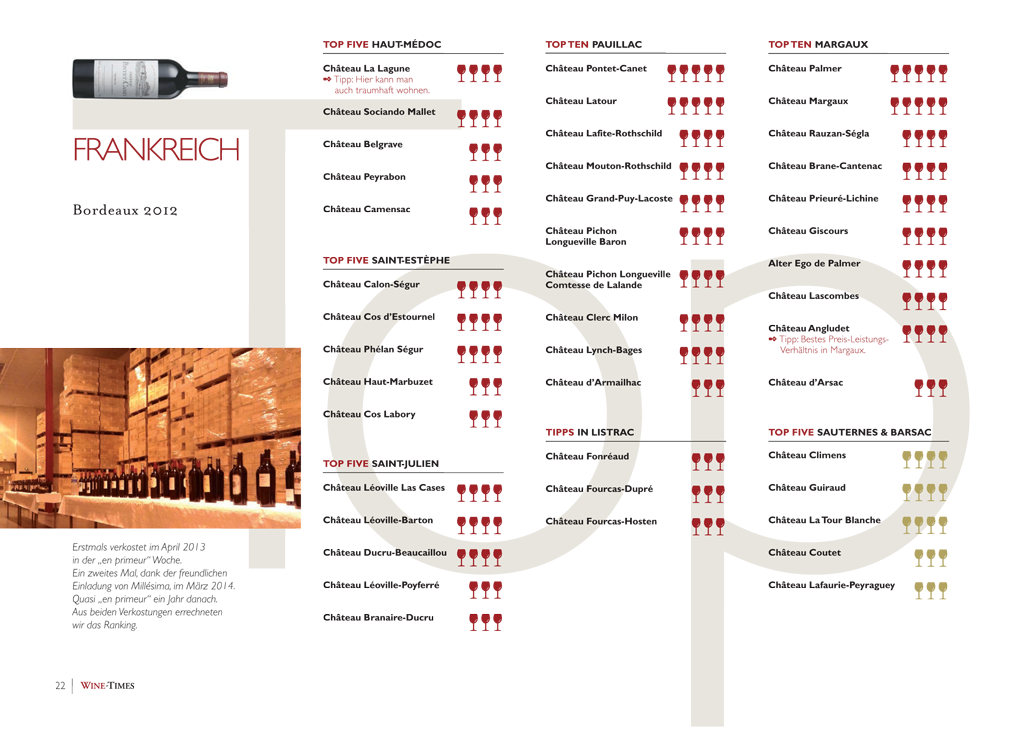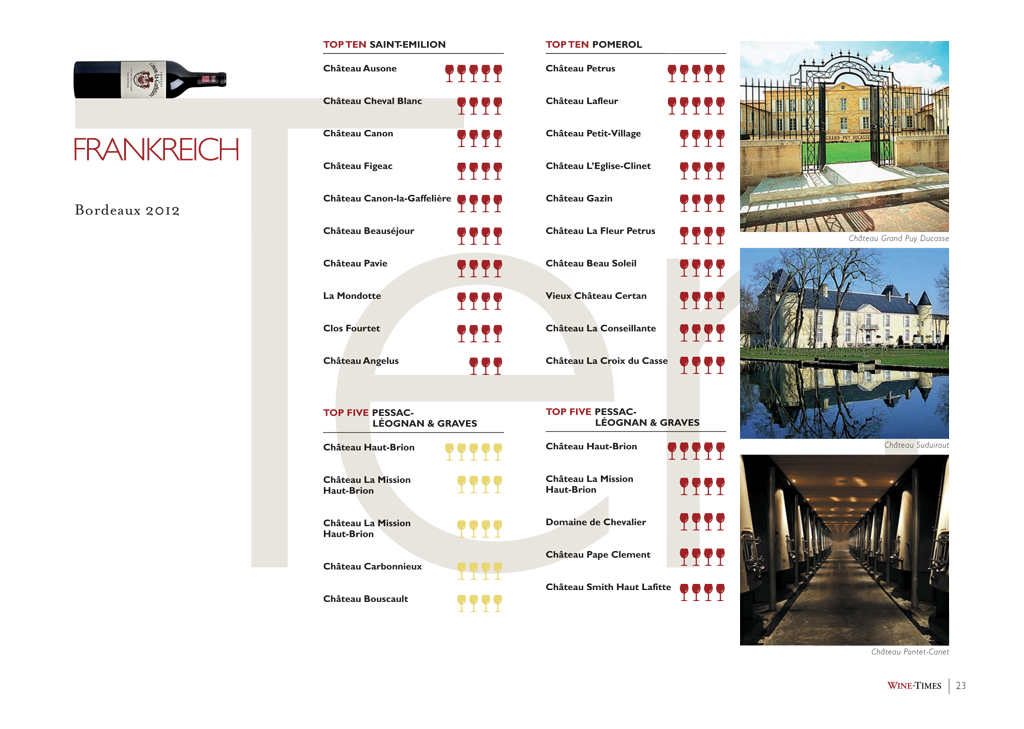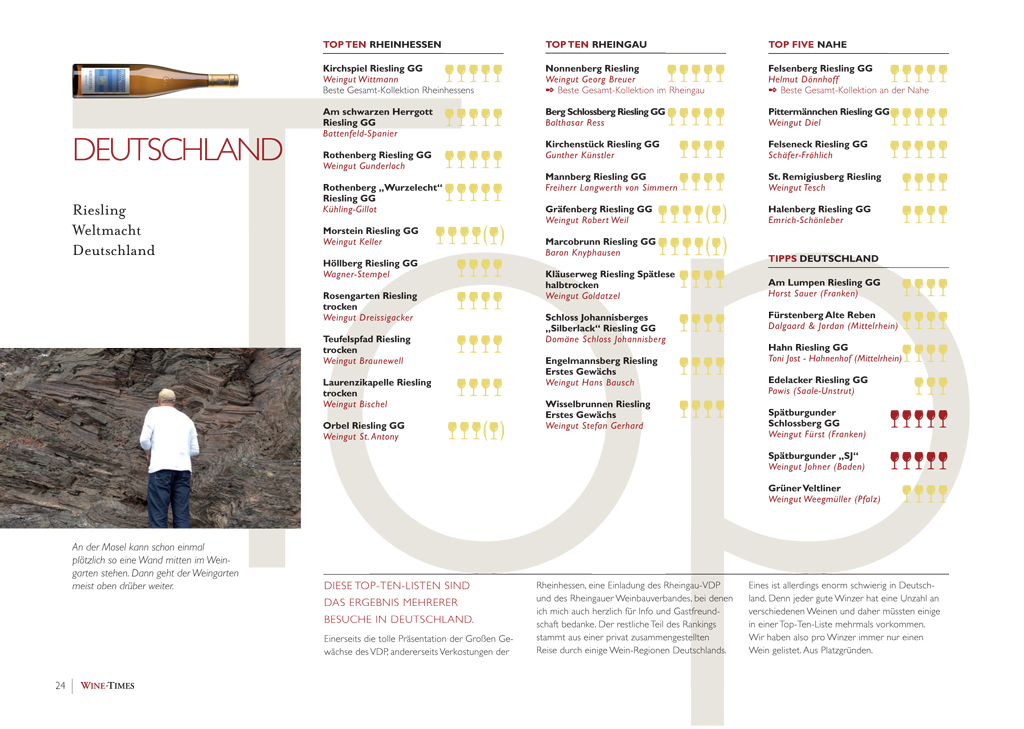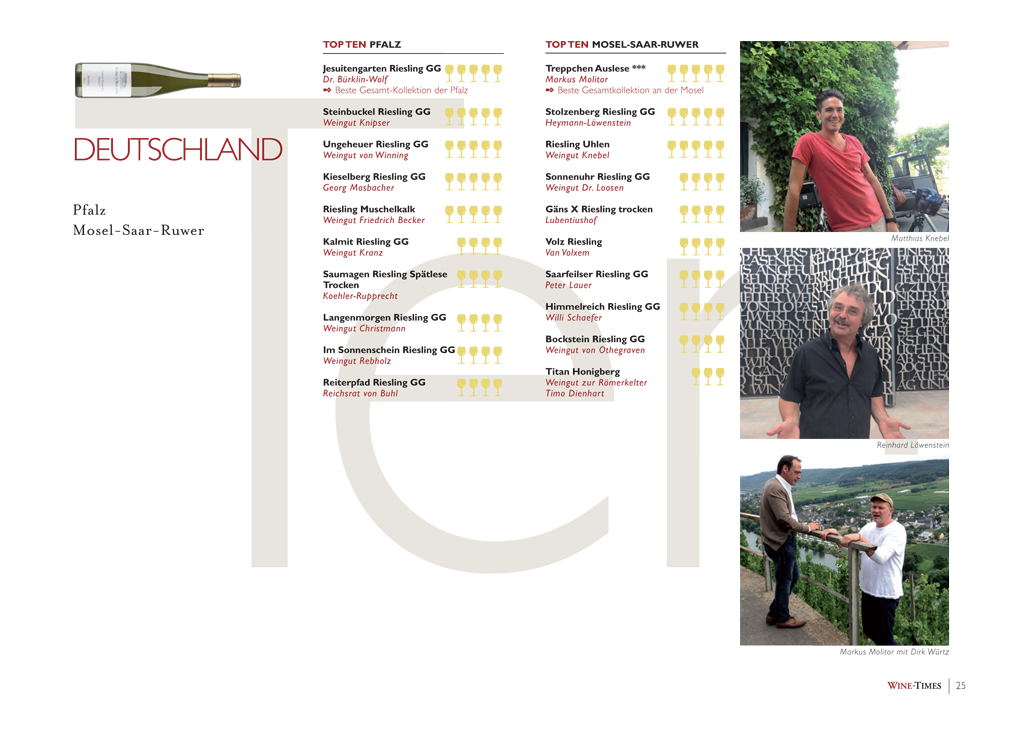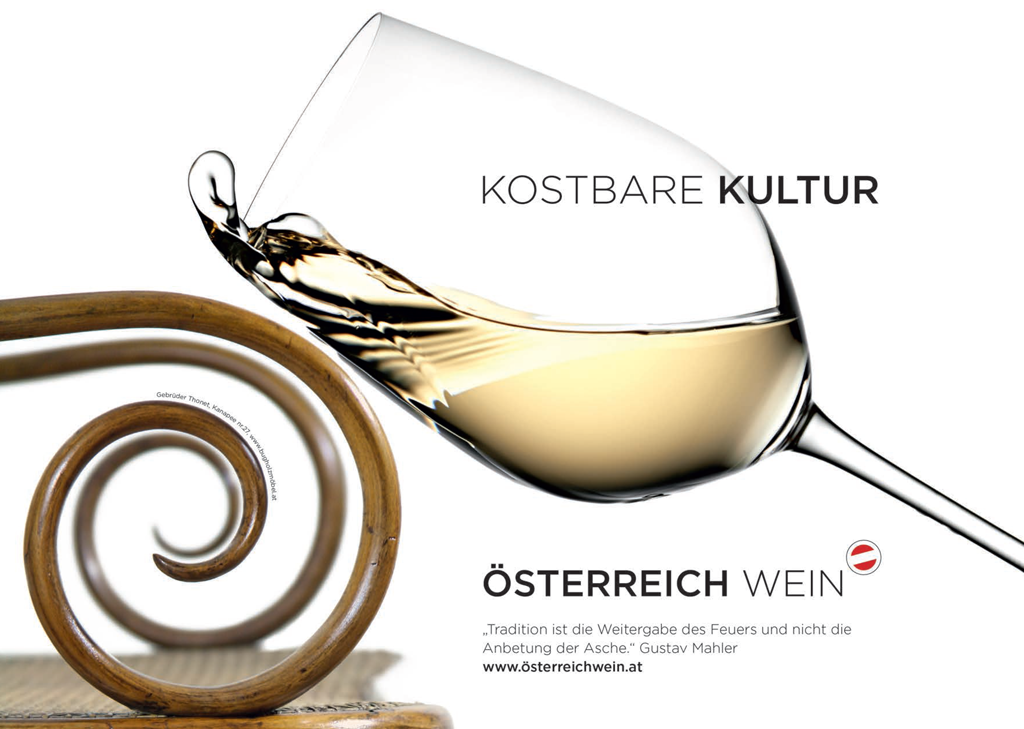Hier geht's zum aktuellen Wine-Guide-Austria in deutscher Sprache, dem ultimativen Nachschlagewerk zum österreichischen Wein.
Flowers and hail - not the holy grail.
This year, in May, Bordeaux was really and truly hit hard and brutally by hail. Read a comment by John U. Salvi.

Count John U. Salvi (MW)
There is a cautionary tale in England about the little boy who cries « wolf ». The meaning and moral of the tale is that when a person shout for help over and over again, about something that turns out not to need help, when he shouts and really and truly does need help nobody believes him and nobody takes any notice.
The Bordelais have earned exactly this reputation. Almost every spring they shout “frost” after a cold night with perhaps just a touch of it, but little or no damage, often seemingly in the hope that it will allow them to raise their opening prices or at least keep them higher than they should be.
I remember clearly the severe early morning frost of 20-21st April 1981. The Union des Grands Crus were holding a huge tasting in London on 21st and the Bordeaux growers arrived weeping salt tears and wringing their hands. To their utter dismay nobody believed a word of their tale of woe. “You are at it again trying to raise your prices” said the British Wine Trade, “we don’t believe a word you say”!
This year, in May, Bordeaux was really and truly hit hard and brutally by hail. No fictitious “wolf” this time but a genuine big, bad wolf. None the less it has taken considerable time before everybody has believed them and they have had much less sympathy than they actually deserve.
Also, since it is so very expensive to insure against hail, only a small number of top growers had done so and the loss of all the many smaller growers is total. When hail strikes in the vineyards it is very hard to estimate the real extent of the damage for quite some time and we hear the wildest of stories. This year it only became clear during the flowering, which has just recently finished after being somewhat long and drawn-out.
The hailstones were large – really large! My son, who lives at Saint André de Cubzac, was sure that nobody would believe him about the size so he gathered a few handfuls and put them in his deep freeze. The stones were the size of quails’ eggs. The problem with such large stones is that they not only strip the leaves and cut the stalks of the baby bunches so that they wither and fall, but it also scores and damages the wood of the vine and this has serious repercussions on next years potential (2010 vintage), by stunting and warping the growth.
In some places the hail struck up to 3 times.
Créon, for example, was seriously hit by all three hailstorms. As nearly always it falls haphazardly in various different zones in long narrow corridors.
The two worst storms took place during the evening of 11th and during the night of 12th-13th May. They were ferocious and violent. The first hit mainly Cognac, Bourg, Blaye, Rouillac, Eysines, Blanquefort, Mérignac, Branne, Créon and the north and south Médoc taking in Châteaux d’Issan and Kirwan. The Médoc damage however was mild compared to the others. Parts of Saint Emilion were devastated. Bourg, Blaye, Branne Créon and Saint Emilion were also badly hit by the second storm and Créon by the third just a few days later. During the first storm 4,700 bolts of lightning struck. To show how localised they were, huge stones struck the Mérignac vineyards but none fell just 3 kilometres away.
The very worst of these hailstones fall when cumulo-nimbi form, on the spot, sometimes in even less than 20 minutes. These can be devastating.
Unfortunately the storms took place just when the “contre-bourgeons” were forming. For every bud on the vine a “counter-bud” forms but does not usually develop into a ripe bunch of grapes. Good growers remove them. This year, for some growers, they may make the difference between life and death. If they were already formed then they were destroyed, but if they had not yet come out of the wood then they would have been able to do so and if we get a really good, hot summer they could develop into second generation grapes.
Estimates still vary tremendously and are hard to argue with. It is impossible to know how much a grower has exaggerated without walking round his vineyard. However it is absolutely safe to say that between 5,000 – 8,000 hectares have been damaged up to 80% or even more.
To give just one example, Château Trottevieille, in Saint Emilion, has been totally written off. There is hardly a bunch left and they have decided not even to try and pick at all this year but to concentrate on pruning and treating the vine to ensure that it can function properly next year. This is truly dramatic and a huge, hungry, rapacious wolf has rampaged through their vines and those of many others. Incidentally, the stones were large enough and heavy enough to do over 1,000 Euros worth of damage to the roof of my son’s car, which was parked outside his front door.
A long and drawn-out flowering.
Our other problem this year was a rather long and drawn-out flowering period, although it was not as long as it seemed at the time or as some growers pretend. We like the flowering to take place during fine, calm, sunny, warm to hot weather and to take just two weeks. This year it took between 18-20 days. A long flowering means an uneven flowering and this means uneven ripening. The phenomenon is known as “millerandage”. It means that at vintage time the grower finds both ripe and unripe grapes on the same bunch.
This year the flowering started perfectly during the last days of May for the very earliest and precocious vines, perhaps a little late because of previous cold weather, during a lovely, hot, sunny spell, which went from 27th May to 4th June inclusive? By 4th it was fully under way in all areas. However we then had 7 consecutive wet and very cool days, almost cold, with 40.6mm of rain, from 5th – 11th, right in the middle of the flowering. Some of these days did not even reach 20°C. This slowed the whole process down and dragged it out. 12th and 13th were dry, but then 14th and 15th poured with no less than 28.6mm of rain. This made 69.2mm of rain during the flowering period, which nobody could or can casually shrug off!! After that we had another fine, dry spell, and flowering was generally over by 20th, but the heat after the rain produced tremendous humidity and mildew attacked with a vengeance. A lot of spraying has already been necessary this year and this is extremely expensive, especially for the smaller growers.
The rain also makes the caps stick on the just formed grapes instead of falling off and these future grapes then wither and die. This is called “coulure”. Thus we approach the end of June with a few incipient problems. Most of these can be handled by efficient viticulture, but the disastrous damage done by the hailstorms is irrevocable, has ruined this year’s crop for many growers and may well have damaging effects on that of 2010. Any “millerandage” and “coulure” will also reduce the size of the 2009 vintage!
The Bordelais have earned exactly this reputation. Almost every spring they shout “frost” after a cold night with perhaps just a touch of it, but little or no damage, often seemingly in the hope that it will allow them to raise their opening prices or at least keep them higher than they should be.
I remember clearly the severe early morning frost of 20-21st April 1981. The Union des Grands Crus were holding a huge tasting in London on 21st and the Bordeaux growers arrived weeping salt tears and wringing their hands. To their utter dismay nobody believed a word of their tale of woe. “You are at it again trying to raise your prices” said the British Wine Trade, “we don’t believe a word you say”!
This year, in May, Bordeaux was really and truly hit hard and brutally by hail. No fictitious “wolf” this time but a genuine big, bad wolf. None the less it has taken considerable time before everybody has believed them and they have had much less sympathy than they actually deserve.
Also, since it is so very expensive to insure against hail, only a small number of top growers had done so and the loss of all the many smaller growers is total. When hail strikes in the vineyards it is very hard to estimate the real extent of the damage for quite some time and we hear the wildest of stories. This year it only became clear during the flowering, which has just recently finished after being somewhat long and drawn-out.
The hailstones were large – really large! My son, who lives at Saint André de Cubzac, was sure that nobody would believe him about the size so he gathered a few handfuls and put them in his deep freeze. The stones were the size of quails’ eggs. The problem with such large stones is that they not only strip the leaves and cut the stalks of the baby bunches so that they wither and fall, but it also scores and damages the wood of the vine and this has serious repercussions on next years potential (2010 vintage), by stunting and warping the growth.
In some places the hail struck up to 3 times.
Créon, for example, was seriously hit by all three hailstorms. As nearly always it falls haphazardly in various different zones in long narrow corridors.
The two worst storms took place during the evening of 11th and during the night of 12th-13th May. They were ferocious and violent. The first hit mainly Cognac, Bourg, Blaye, Rouillac, Eysines, Blanquefort, Mérignac, Branne, Créon and the north and south Médoc taking in Châteaux d’Issan and Kirwan. The Médoc damage however was mild compared to the others. Parts of Saint Emilion were devastated. Bourg, Blaye, Branne Créon and Saint Emilion were also badly hit by the second storm and Créon by the third just a few days later. During the first storm 4,700 bolts of lightning struck. To show how localised they were, huge stones struck the Mérignac vineyards but none fell just 3 kilometres away.
The very worst of these hailstones fall when cumulo-nimbi form, on the spot, sometimes in even less than 20 minutes. These can be devastating.
Unfortunately the storms took place just when the “contre-bourgeons” were forming. For every bud on the vine a “counter-bud” forms but does not usually develop into a ripe bunch of grapes. Good growers remove them. This year, for some growers, they may make the difference between life and death. If they were already formed then they were destroyed, but if they had not yet come out of the wood then they would have been able to do so and if we get a really good, hot summer they could develop into second generation grapes.
Estimates still vary tremendously and are hard to argue with. It is impossible to know how much a grower has exaggerated without walking round his vineyard. However it is absolutely safe to say that between 5,000 – 8,000 hectares have been damaged up to 80% or even more.
To give just one example, Château Trottevieille, in Saint Emilion, has been totally written off. There is hardly a bunch left and they have decided not even to try and pick at all this year but to concentrate on pruning and treating the vine to ensure that it can function properly next year. This is truly dramatic and a huge, hungry, rapacious wolf has rampaged through their vines and those of many others. Incidentally, the stones were large enough and heavy enough to do over 1,000 Euros worth of damage to the roof of my son’s car, which was parked outside his front door.
A long and drawn-out flowering.
Our other problem this year was a rather long and drawn-out flowering period, although it was not as long as it seemed at the time or as some growers pretend. We like the flowering to take place during fine, calm, sunny, warm to hot weather and to take just two weeks. This year it took between 18-20 days. A long flowering means an uneven flowering and this means uneven ripening. The phenomenon is known as “millerandage”. It means that at vintage time the grower finds both ripe and unripe grapes on the same bunch.
This year the flowering started perfectly during the last days of May for the very earliest and precocious vines, perhaps a little late because of previous cold weather, during a lovely, hot, sunny spell, which went from 27th May to 4th June inclusive? By 4th it was fully under way in all areas. However we then had 7 consecutive wet and very cool days, almost cold, with 40.6mm of rain, from 5th – 11th, right in the middle of the flowering. Some of these days did not even reach 20°C. This slowed the whole process down and dragged it out. 12th and 13th were dry, but then 14th and 15th poured with no less than 28.6mm of rain. This made 69.2mm of rain during the flowering period, which nobody could or can casually shrug off!! After that we had another fine, dry spell, and flowering was generally over by 20th, but the heat after the rain produced tremendous humidity and mildew attacked with a vengeance. A lot of spraying has already been necessary this year and this is extremely expensive, especially for the smaller growers.
The rain also makes the caps stick on the just formed grapes instead of falling off and these future grapes then wither and die. This is called “coulure”. Thus we approach the end of June with a few incipient problems. Most of these can be handled by efficient viticulture, but the disastrous damage done by the hailstorms is irrevocable, has ruined this year’s crop for many growers and may well have damaging effects on that of 2010. Any “millerandage” and “coulure” will also reduce the size of the 2009 vintage!
© by Weinspitz_Helmut_Knall
last modified: 2009-07-07 21:38:28
last modified: 2009-07-07 21:38:28






















